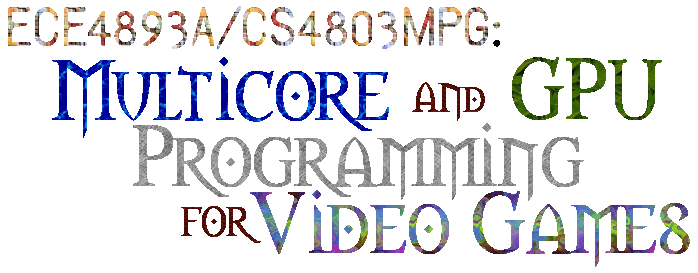
Related classes
Link to courses on both multicore and GPU processing:
- UIUC ECE498AL –
Programming Massively Parallel Processors (lots of emphasis on CUDA) - Univ. of Central Florida
CDA 6958
– Multi-core/Many-core Architectures and Programming (Covers CUDA and
Cell, but also has strong ATI focus)
Links to courses on multicore processing:
- MIT 6.189 – Multicore
Programming Primer: Learn and Compete in Programming
the Playstation 3 Cell Processor, a
“Independent Activities Period”
course that took place during January 2007. Appeared to cover Cell
programming, but not GPU programming. Open to all students! - Mercer
University SSE
689 – Multicore Software. Students required to provide their own
computer with a multicore processor, typically Intel (although AMD and IBM
allowed). - CS 8803/4803: Multicore Computing
Links
to courses on GPU architecture and also possibly GPGPU programming:
- Caltech CS101.3:
Hacking the GPU, “open to grads and undergrads
with a background in
either graphics,
numerical analysis, computer languages or computer architecture.” - Univ. of Aarhus CS
GPGPU (Q2 2004) - UNC at Chapel Hill COMP 290-058: General Purpose Computation
using Graphics Processors - Stony Brook University
CS690 –
General Purpose Computing on
Graphics Hardware. “Graduate standing or permission of instructor.”
“The course is intended for anyone
who has encountered a need for
accelerated computing. The material
and its presentation is suited for a
general audience from all academic
displines. The only prerequisite
is knowledge of a programming language,
preferably C/C++. No prior knowledge
of computer graphics is required,
but some mathematical background,
such as linear algebra, is desirable.” - Univ. of Illinois at Chicago
CS 594 – Special
Topics – GPU Programming. Assumes
computer graphics/OpenGL background. - UC Davis, EEC227
– Graphics Architecture.
“Ideally, students should
have a background in both
computer architecture (at the level of EEC 170 or ECS 154B) and
computer graphics (at the level of ECS 175). Students should also
have a reasonable familiarity with the C programming language. - Stanford CS448A – Real-Time Graphics Architectures.
“The class is open to students with a background in computer graphics or
computer systems and architecture. It may be taken for 1 or 3 credits.
For 1 credit, each student will be expected to attend all the lectures
and participate in discussions. For 3 credits, two projects will be assigned.
The first will be to analyze tradeoffs in graphics architectures, and the second will be to design part of a graphics system.” - U. Penn CIS
700/010 (Special Topics) – GPU Programming and
Architecture.

